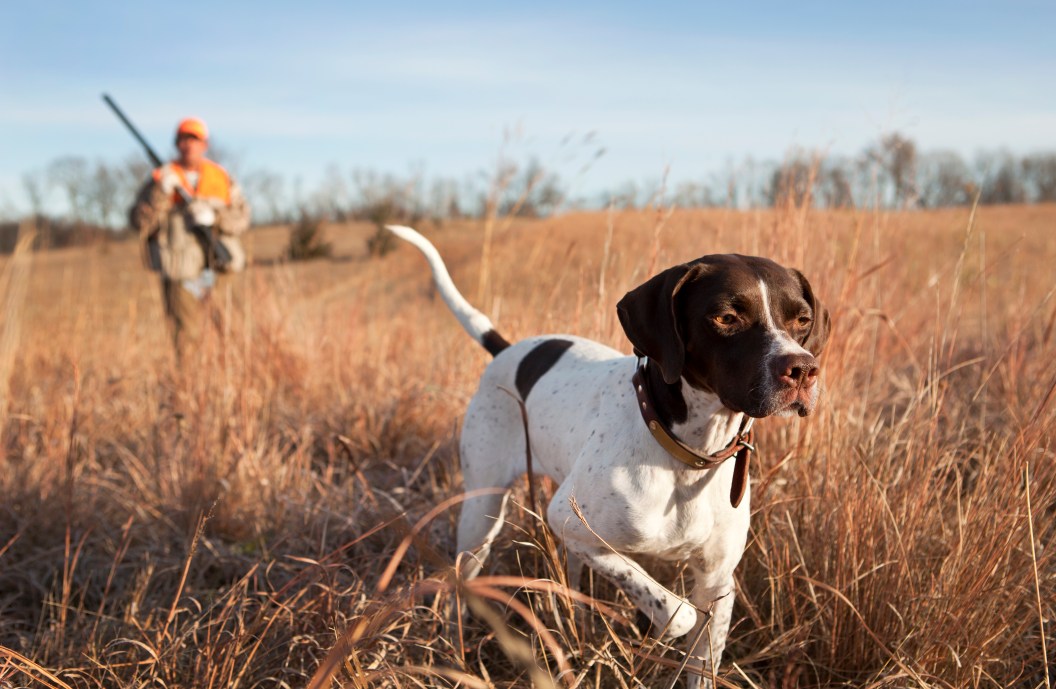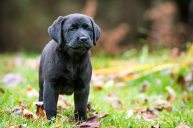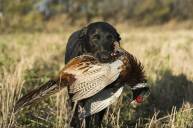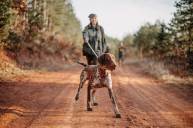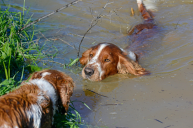Dogs are not only a man's best friend, they can also be a hunter's. Not only do canines offer incredible companionship in the field and at home, but if properly trained and used well they also increase the chances of a successful hunting trip. But how do you choose among Labrador retriever, pointer, or hound to select the right breed for your outdoor endeavors? We did the research to help you pick your next pup from the best hunting dog breeds.
A Brief History of Hunting Dogs
People have been using dogs to hunt for nearly 12,000 years; they were such an integral part of some culture's hunting that people even carved images of them into cliffs. An 8,000-year-old rock art scene in Saudi Arabia shows a bowhunter surrounded by 13 dogs, two on leashes, all of them with their own individual coat markings.
While it's impossible to tell what breed these ancient dogs are—and, to be fair, most dogs back then may have been mutts—modern-day hunters can be a lot pickier about what breed and bloodline of dog they take out hunting. Training a dog to be the perfect hunting companion is a laborious process, and you want to be sure you're putting your efforts into a dog with the right instincts and athleticism to perform well under pressure.
What To Know About Owning Hunting Dogs
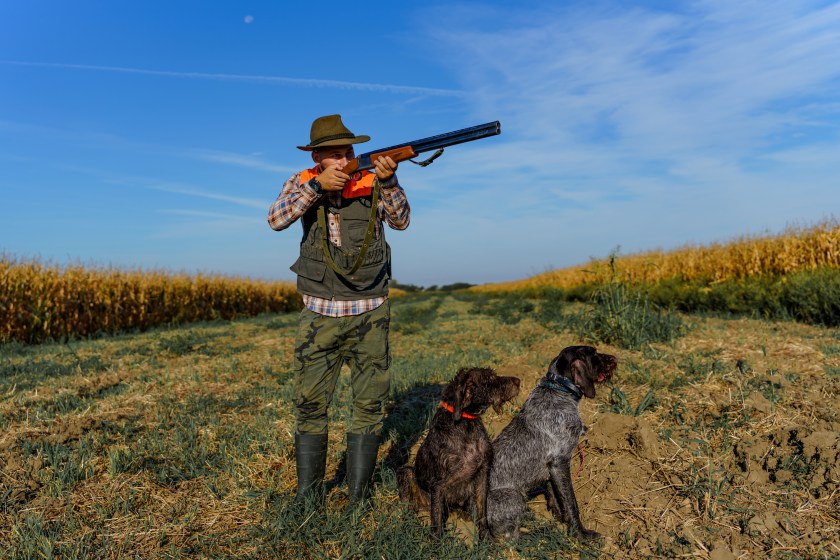
Getty Images, RealPeopleGroup
The commitment to finding, acquiring, training, and living with a hunting dog is unlike any other animal-human relationship. In order to make the most out of it, you have to be willing to dedicate a lot of time, money, and effort to turning a new puppy into a gun dog.
The most important part starts before you ever bring your dog home. Do your research and know not only what kind of breed you want, but also where you'll get your dog from. Reputable breeders may not always be in your neck of the woods and they're almost always going to charge a premium. The better a dog's specific bloodline, the higher the demand, and therefore the more costly the initial investment. Great hunting dogs from proven lineages do not come cheap.
That upfront cost also doesn't include essentials like dog food or training equipment. These dogs are athletes, and as such need high-quality food and consistent care to make sure they're in top-notch condition. You'll also need to make sure they're getting plenty of exercise. These are working dog breeds, and without a job and some mental stimulation, they can very quickly turn to misbehaving and acting out.
When it comes time to start hunt training—which can be very early for most breeds—the real challenge begins. There's no lack of dog-training books, online courses, and instructional materials out there, but you'll need to find something that works for both you and your dog. Without the right kind of training, your dog may never reach its full potential. If you aren't able to commit to daily or near-daily training in lengthy sessions, you might want to opt for sending your gun dog away to a professional facility that can do the majority of the work for you.
Whichever breed or training method you choose, know that the ownership of any animal, especially a dog, is a full-time responsibility, and not an undertaking that should be taken lightly. Any dog deserves a good life, and one spent hunting with its owner can certainly fill the bill. Take it seriously, and you'll quickly realize what makes gun dogs so special.
Types of Hunting Dogs
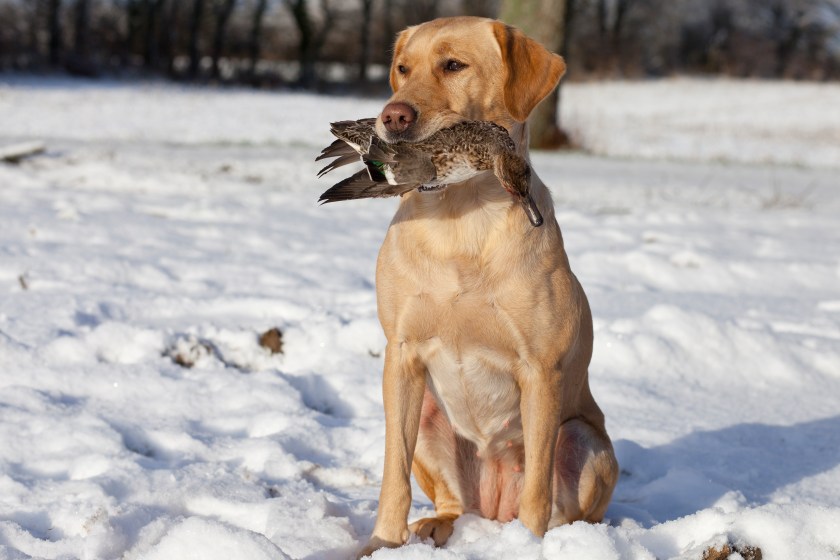
Getty Images, juliazara
There are many different types of hunting dogs, all bred to have particular skills or hunt certain types of animals. Hunting dog groups can largely be broken into five different categories: terriers, pointers, retrievers, flushers, and hounds. Each group consists of many different breeds, however, all bred for a specific purpose or type of hunting.
Ranking hunting dog breeds isn't a one-size-fits-all deal, as each breed has its unique strengths and weaknesses. Every hunting breed shines in certain areas. The key is to match your specific hunting needs with the appropriate breed; an upland hunter will require different traits in a dog than a goose hunter or a rabbit hunter would.
We've dug up the top 20 breeds, separated by hunting group, that we think any hunter should consider. Just remember, it takes a lot to cultivate a successful partnership with your four-legged hunting companion. If this will be your first hunting dog, the level of dedication needed is eye-opening, and you need to familiarize yourself with the basics of a breed before making a serious commitment.
Best Hunting Dogs by Group: The Terriers
These smaller dog breeds mostly originate from the United Kingdom and were originally bred as pest control for houses and farms. Though many are compact in size, they can be ferocious and tenacious and are great for hunting small game, birds, and in the case of pit bull terriers, even boars.
1. Jack Russell Terrier
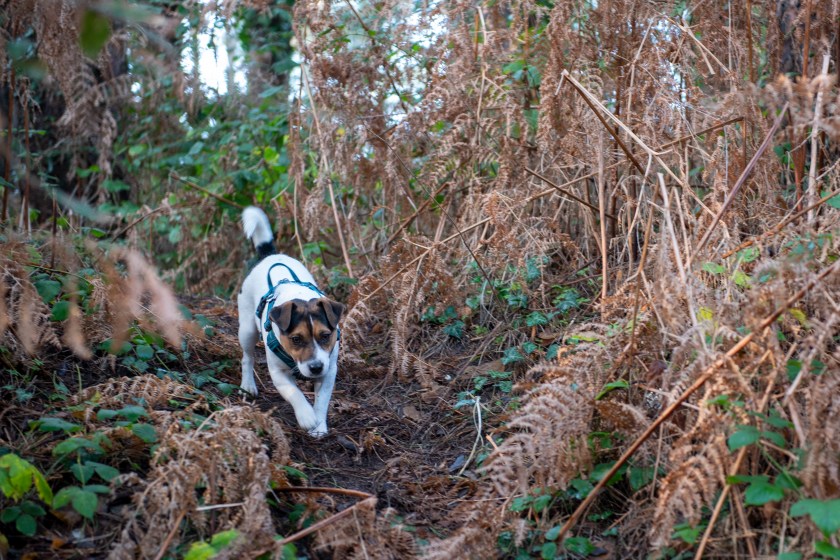
Getty Images, StephM2506
Breed Characteristics: Tough, tenacious, incredibly friendly
Jack Russells have been bred for hunting for over 200 years. Originally used to flush foxes out of their underground burrows, these small, agile dogs are both relentless and fearless. They can be used for all sorts of small game hunting, as well as varmint control. They can also be trained to retrieve waterfowl and track blood trails.
Jack Russells can make great family pets, though their high prey drive and stubbornness are a challenge. Thankfully, they're small enough to handle easily in most situations.
2. Airedale Terrier
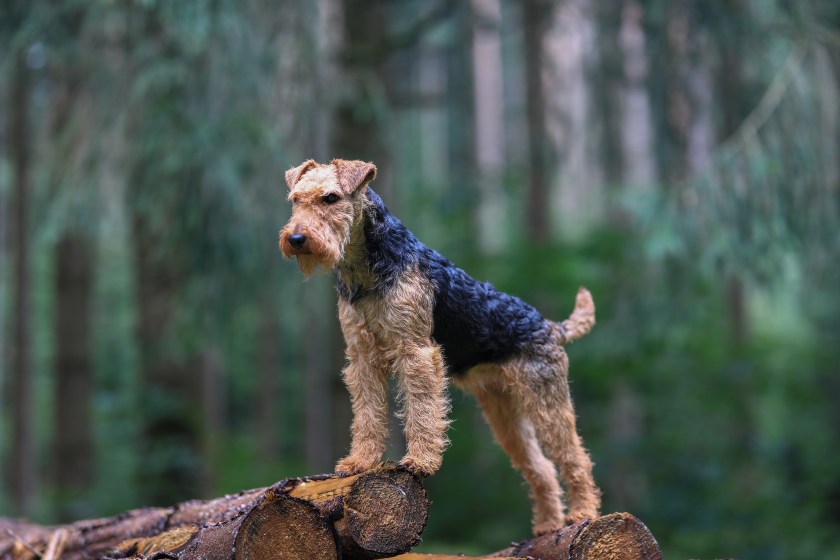
Getty Images, Martina Cross
Breed Characteristics: Intelligent, loyal, easy to train
One of the largest of the terrier group, Airedale terriers were originally bred in England as do-it-all hunters. While they were originally used to hunt river rats, they were quickly employed as both bird finders and retrievers by hunters in Yorkshire.
Today, Airedales are used to hunt both birds and fur-bearing game. Like most terriers, they're incredibly tough and tenacious. They also have a goofy and comical side and make great household pets. The Airedale's suitability as a family dog has made it difficult at times for the breed to receive the recognition it deserves as a sporting dog.
3. American Pit Bull Terrier
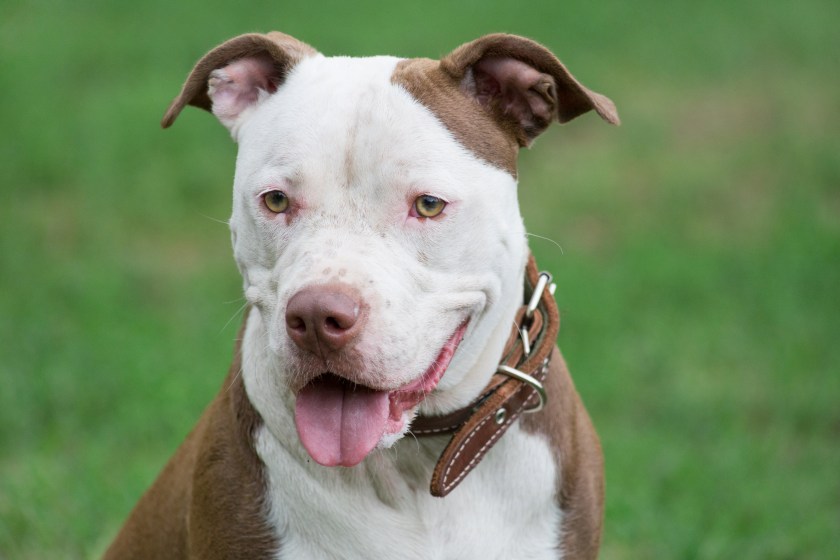
Getty Images, SergeyTikhomirov
Breed Characteristics: Incredible strength, impressive speed, dogged determination
If you don't live in hog country, you probably would've never guessed a pit bull could hunt. Unlike other terriers, pit bulls can take down far larger game because of their strength and size. The American pit bull terrier is what hunters call a "catch dog," meaning it attacks its quarry. And the quarry it's usually trained to go after? Boars.
Typically, this means outfitting the dog in some kind of chest and neck armor (usually Kevlar) to protect it from a boar's tusk. On command, the pit will get its teeth on the bottom of a boar's ear and hold it until a hunter comes to finish the job.
Best Hunting Dogs by Group: The Pointers
Pointers are upland heroes. They're bred to be able to spot prey, both for small game and big game hunting. These dog breeds are named for the easily recognizable stance they take when they've spotted prey: front paw up, tail erect, and nose pointing at the animal.
4. German Shorthaired Pointer
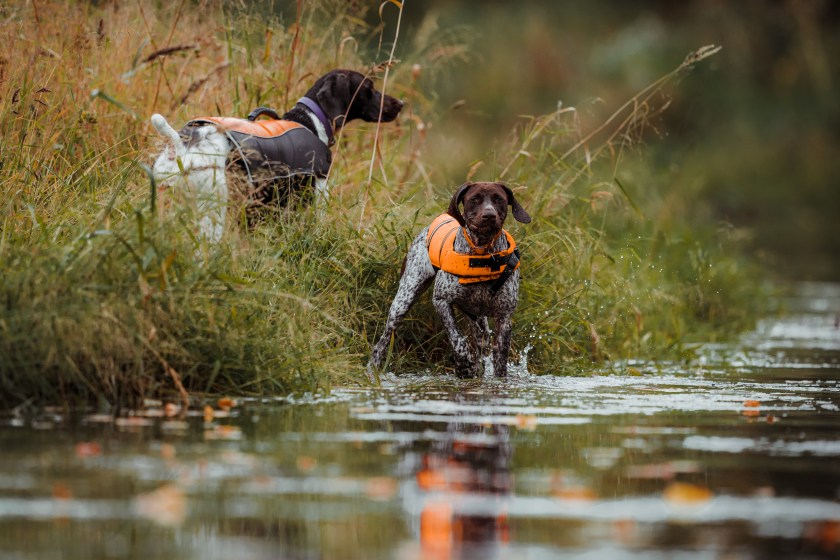
Getty Images, johany
Breed Characteristics: High energy, high stamina, excellent swimming ability
The German shorthaired pointer has gradually become the icon for all bird hunting, and for good reason. This breed is as versatile as they come. Its webbed feet make it an exceptional swimmer, its relentless nose can practically find a bird from the next state over, and its stamina keeps it going as long as your own legs will hold up.
That endurance isn't always useful, though. Of all the dogs on this list, the German shorthaired pointer easily has the most energy, making it a nightmare for those who don't have adequate time or space to exercise a dog. If you go with one, be prepared to run yourself ragged trying to tire it out on non-hunting days.
5. German Wirehaired Pointer
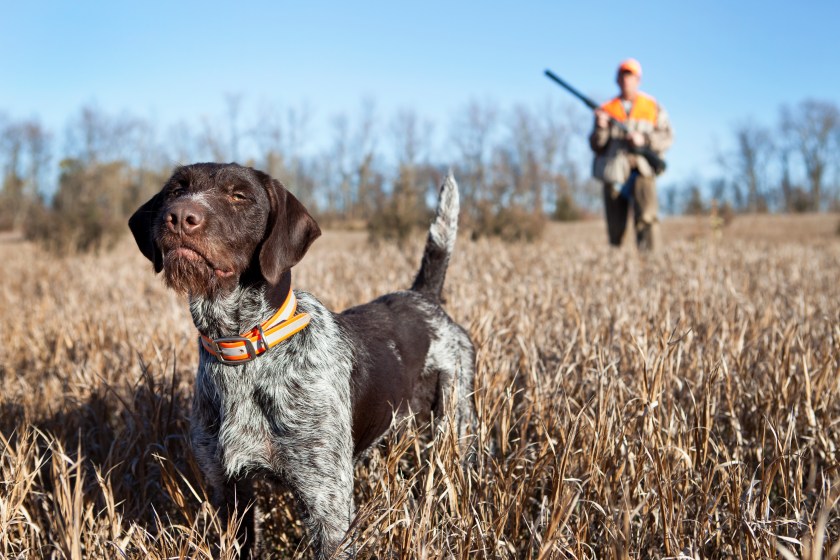
Getty Images, JMichl
Breed Characteristics: Determined, versatile, unique appearance
You could sum up the German wirehaired pointer in one word: tough. Most hunting dogs are eager to go the extra mile but with some limitations. Except for the wirehair, that is. This is a dog with no regard for its own comfort. The majority of bird hunters are familiar with the feeling of shooting a bird and watching it fall in an unfortunate place like a thicket or a freezing-cold pond. In scenarios where many dogs will draw the line, the German wirehaired pointer excitedly accepts the challenge.
A German descendent of the griffon, the German shorthaired pointer, the Pudelpointer, and the Deutscher Stichelhaar, this breed meets the needs of both upland and waterfowl hunters. Similar to a German shorthaired pointer, a wirehaired pointer can present the issue of having excess energy in the off-season, meaning you'll need to incorporate plenty of exercise into your daily routine.
6. Vizsla
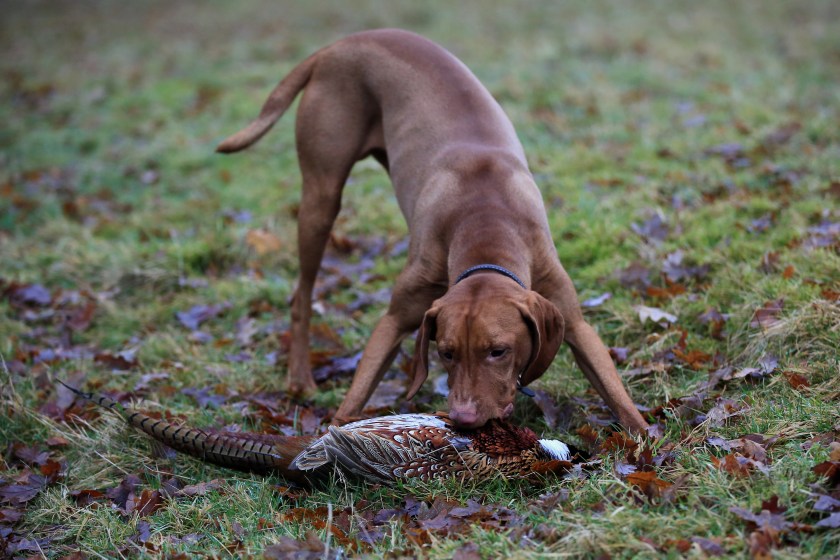
Getty Images, The_Chickenwing
Breed Characteristics: Driven, technically sound, good household pet
Hailing from Hungary, the Vizsla is another dog breed that can do it all. While it's made its name in pursuit of upland birds, a well-trained Vizsla can also outperform a Labrador retriever in the swamps. The key to getting the most out of a Vizsla, though, is the proper communication. This is one dog that's notorious for being sensitive, which can make it receptive to training—or build an unbreakable wall. The Hungarian hunter is known for taking harsh discipline very poorly, so gentle commands and positive reinforcement are imperative.
The Vizsla isn't particularly big, which is often appealing to those looking for a family dog to have in the house. However, it has just as much energy as a German shorthair or wirehair. Needless to say, exercise is a must.
7. English Pointer
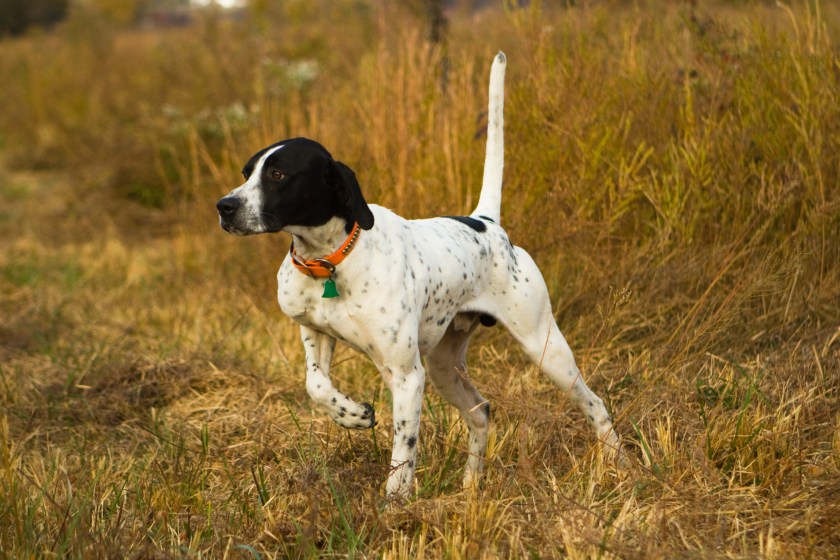
Getty Images, timalfordphoto
Breed Characteristics: Fast and driven, warm-weather tolerant, highly trainable
English pointers shine on hunting trips, are great for tracking small prey, and have an instinctual desire to point. Inexperienced hunters may find that this pointer trains you, with its speed and drive to find game.
The English pointer is incredibly popular in the south—it's simply referred to as a "pointer" in Texas—thanks largely to their ability to handle hot climates during those early-season hunts. If you're an uplander who spends the better part of a season afield, there may be no better choice out there.
8. Weimaraner
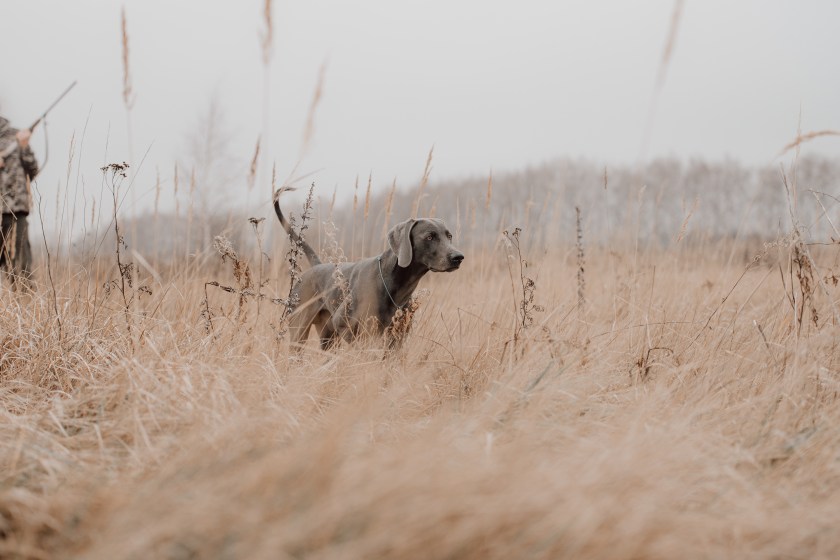
Getty Images, Ksenia Raykova
Breed Characteristics: Athletic, well-rounded, high-energy
Sometimes growing up to 90 pounds, the Weimaraner is one of the biggest sporting breeds with an instinct to point. What's so impressive about this particular breed, though, is its versatility. While it earned its stripes as an upland partner, it's proven to be the Swiss Army knife of all gun dogs. The Weimaraner can add an edge when hunting for upland game birds, waterfowl, squirrels, rabbits, foxes, deer, bears, hogs, and various predators.
As far as personality goes, the Weimaraner is a high-energy breed that bonds very closely with its owner. So if you're one who has to leave your dog at home for long periods of time, expect to encounter some separation anxiety. Some Weimaraners may favor a close-range approach, never veering more than 30 yards from its gunner. The range tends to correlate more with the individual dog than the breed, but a Weimaraner's temperament matches the feel of a more intimate hunting style.
9. Irish Setter
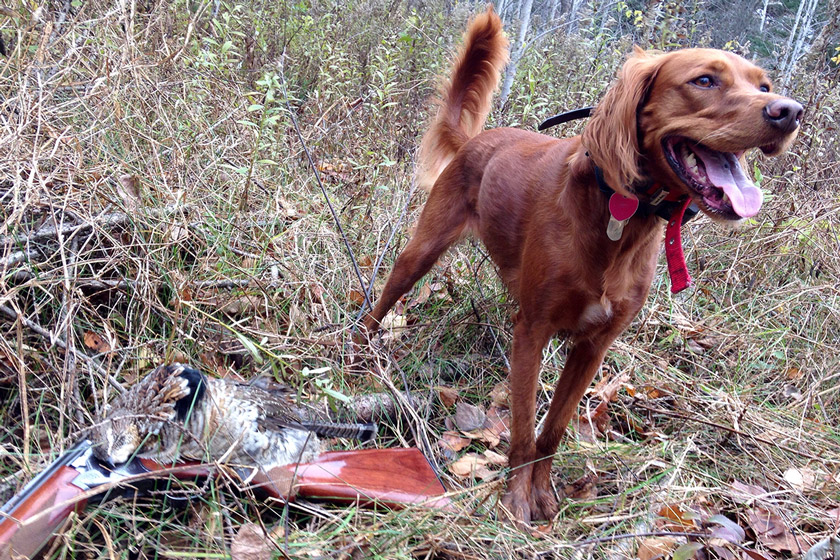
David Schlake for Wide Open Spaces
Breed Characteristics: Good-looking, determined, talented
There's one thing no one can deny when it comes to the Irish setter, and that's its beauty. One of the most stunning dogs any hunter could own, this red dog is hard to look away from.
Irish setters are also phenomenal bird dogs, being both fast and possessing a superior sense of smell. Irish setters are also skilled at tracking, retrieving, and pointing. Like many sporting breeds, the Irish setter exhibits the patience and attention to detail that make it a good hunting dog.
10. Brittany Spaniel
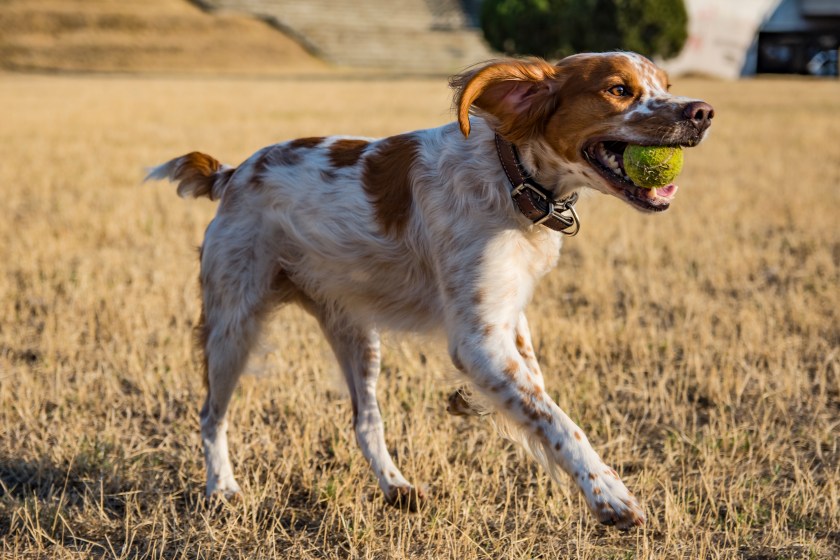
Getty Images, Marko Ignjatovic
Breed Characteristics: Small- to medium-sized, driven, good household pet
The Brittany spaniel is a special bird dog. Although it doesn't have the physique of a German shorthaired pointer or the beauty of many setters, it has enough heart to outhunt any dog on this list—not to mention its loyalty and drive to please its owner.
There aren't many cons to pick from, other than the shedding that inevitably comes with long fur. The Brittany is a fabulous hunter, a sweetheart of a family pet, and a fairly low-maintenance commitment compared to many of the popular sporting breeds.
Best Hunting Dogs by Group: The Retrievers
Labradors, Goldens, and more: These ultimate bird dogs are your waterfowl ride-or-dies. By definition, retrievers are bred to retrieve birds that are shot back to hunters.
A lot of retriever breeds also make great family pets, and the training isn't quite as rigorous as that of a pointer. It definitely isn't a walk in the park, though. Training a dog to sit for hours at a time isn't going to come easy. But when it finally does yield results, the payoff is as sweet as any.
11. Labrador Retriever
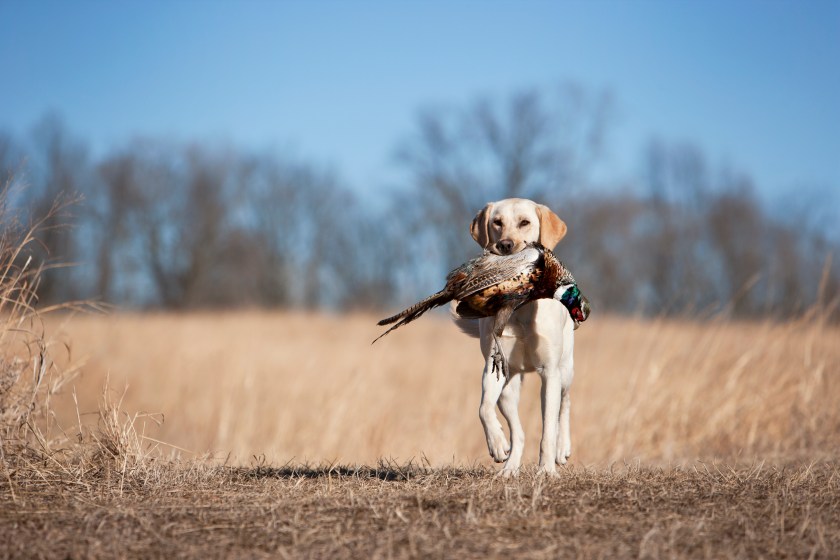
Getty Images, JMichl
Breed characteristics: Excellent in the water, loyal, good household pet
The Labrador retriever is the face of duck hunting and rightfully so. Not only is the Labrador an exceptionally strong swimmer, it also has a powerful drive to please. Any bird hunter will tell you the chemistry between a hunter and their dog is what leads to bag limits. That chemistry is easy to foster with a Labrador.
While this particular breed has become one of the most popular in the United States for non-hunters, too, line breeding is as popular with labs as it is with any upland breed. Your typical household might look at a lab and only see its friendly face and big body, but a seasoned duck hunter sees a venerable athlete ready to work.
The Labrador isn't limited to ducks, either. This gun dog can perform at an elite level in any waterfowl setting. A well-trained lab remains calm for hours but is ready to spring into action on command. The connection between an owner and a lab is strong, and if you take care of them, they'll certainly take care of you.
12. Chesapeake Bay Retriever
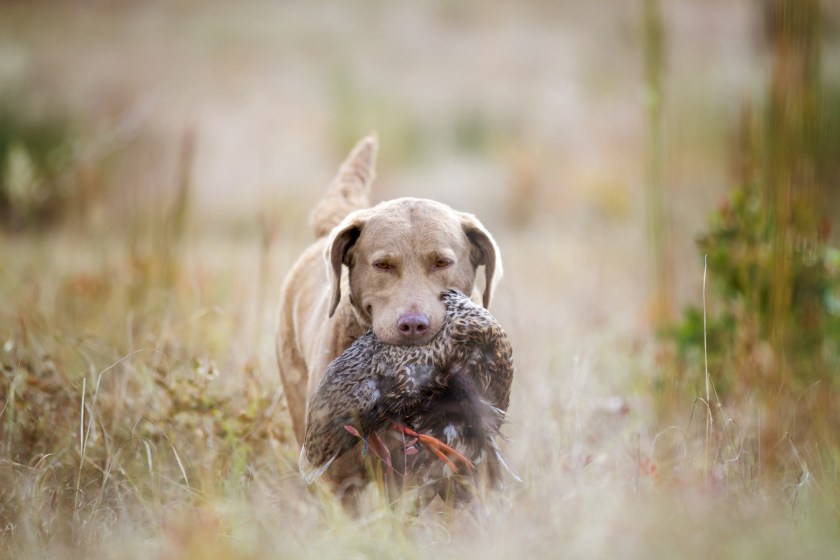
Getty Images, ktatarka
Breed Characteristics: Versatile, great in cold weather, determined
All-season hunters, take note: The Chesapeake Bay retriever will jump into any water, regardless of whether it's warm, cold, or iced over. It comes packed with more energy than a lab, which can be a lot when you aren't sitting in a blind. But, that energy is what powers a Chessie through any element, making it a dependable gun dog you can always count on.
The Maryland state dog also has an interesting history. Its story started with two pups that were pulled from a sinking ship in Maryland in 1807. Thought to be descendants of Newfoundland dogs, each was bred with Irish water spaniels and various hounds. For many years, these dogs were classified as one of three types of "Chesapeake Bay ducking dogs."
13. Golden Retriever
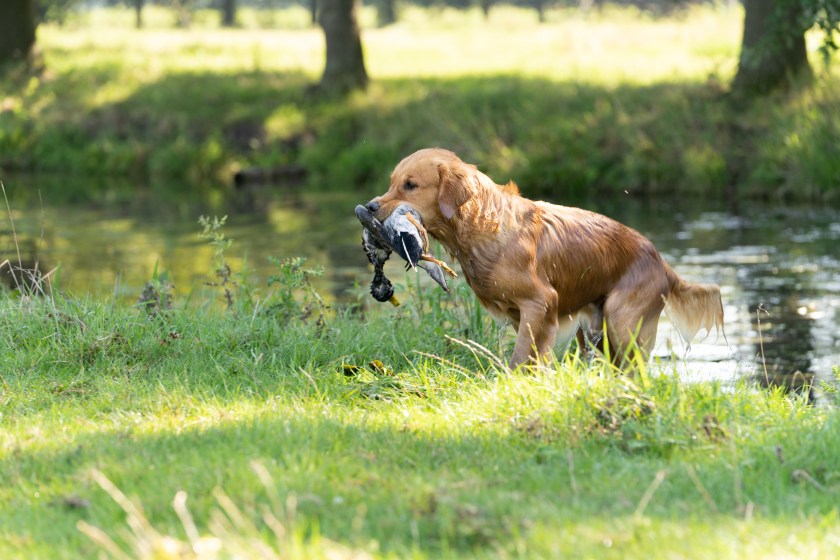
Getty Images, LeoniekvanderVliet
Breed characteristics: Keen sense of smell, driven, great demeanor, good household pet
Who doesn't love the golden retriever? It might as well be "America's dog" at this point. One of the friendliest dog breeds you'll ever encounter, the golden retriever is everything you'd ever want in a family dog. It has a manageable amount of energy, which typically tempers with age, making it fancy the couch more than your typical gun dog will.
While more seen as a household pet than a hunting dog these days, golden retrievers are water dogs at heart, with a long-standing reputation for excellent duck-retrieval skills. The breed has also become popular among upland hunters for its supreme ability to track down fallen birds.
Best Hunting Dog by Group: The Flushers
Flushing dogs are trained to locate live birds and then "flush" them out of their habitat by startling them into flight. While pointers lock into position after spotting game, flushers keep moving in order to push the birds to fly. Instead of finding the bird, pointing and holding, a flusher will run around the other side of it and force it toward the hunter. Many hunters prefer to have both a pointer and a flusher, as the two can complement each other with proper training.
14. Cocker Spaniel
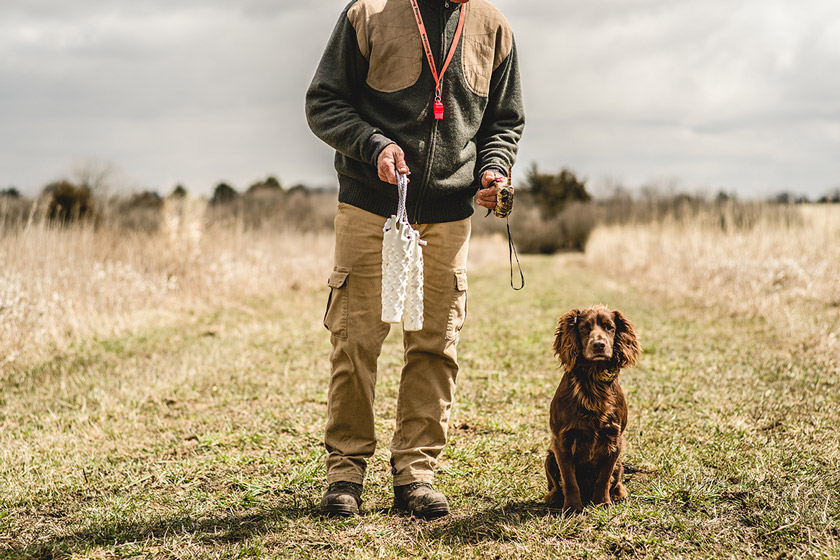
Andrew Howard for Wide Open Spaces
Breed Characteristics: Driven, a stellar sense of smell, great for fallen birds, great household pet
There are two distinct cocker spaniel breeds—the American cocker spaniel and the English cocker spaniel. Their shared name, "cocker," comes from the cocker spaniel's storied role in woodcock hunting. Just about every bird hunter you meet is loyal to a breed, but none more than the owner of a cocker spaniel. In addition to flushing, some hunters put their dogs to work in the marsh as well as the uplands to hunt waterfowl.
The cocker spaniel (both American and English) is a hardworking, loyal gun dog that won't stop until its respective gunner can't walk anymore, which can be excessive at times. Its smaller size and friendly temperament can make it a fantastic family pet, with proper exercise.
15. English Springer Spaniel
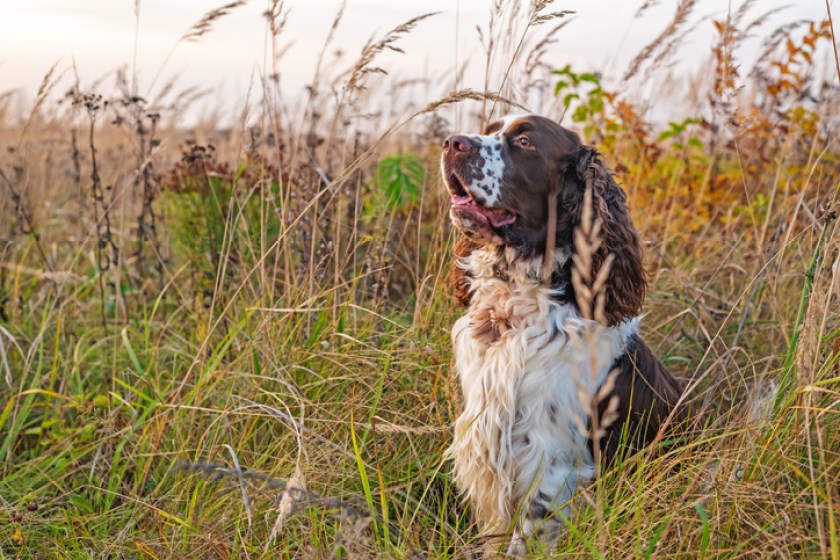
Getty Images, Lusyaya
Breed Characteristics: Versatile, easygoing, affectionate
The English springer spaniel is an iconic breed, particularly for the flushing group. The term "springer" actually comes from the act of flushing or "springing" a bird from cover. This breed has undoubtedly made a name for itself among uplanders, boasting exceptional consistency in both quartering and retrieving.
However, the springer's affectionate personality is often what steals hunters' hearts. Usually between 40 and 50 pounds, it sits at a nice, medium size, making it a great family pet. Its impressive nose and strong drive haven't only paid dividends in the field, but also in the public service industry, as the springer often also serves as a rescue dog in rougher terrain.
16. Boykin Spaniel
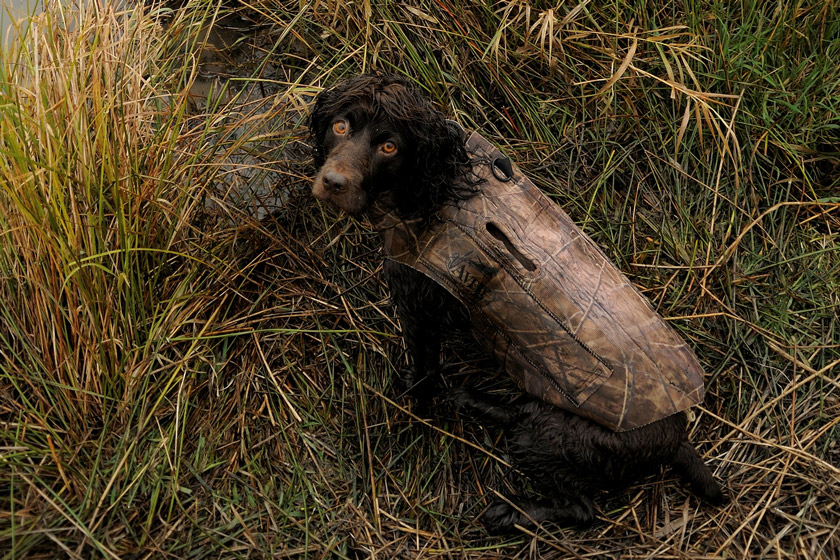
Getty Images, David Williamson
Breed Characteristics: Versatile, great in the water, good household pet
The dual-purpose Boykin is not only a fabulous upland hunter, but a favorite among waterfowl hunters, too. This shouldn't come as a surprise if you're at all familiar with its lineage, as it descends from the Chesapeake Bay retriever, the springer spaniel, the cocker spaniel, the American water spaniel, and several pointing breeds.
The Boykin is an unbelievable swimmer and a perfectionist in the field. Many upland hunters believe their Boykin has the ability to point, but they're actually seeing what some call a "hesitated flush." This gun dog won't flush a bird until it's absolutely positive of where it is, which is invaluable for upland hunters. However, the Boykin has a soft reputation for hesitating in a waterfowl setting, too, which can be tedious if birds are falling and retrieves are the priority.
Best Hunting Dogs by Group: The Hounds
Perhaps the most famed hunting dogs, hounds are known for their keen eyesight and sense of smell. Unlike pointer and flushers, hound dogs are used to hunt four-legged game such as fox, hare, deer, and elk. They excel at following prey by tracking their scent and can also blood-track after an animal has been shot. Because of this, their training is different than bird dogs: When training a dog to hunt birds, the primary focus is discipline. The only discipline a hound needs to live by is the self-control to stay on a scent trail and make a ruckus when they spot their prey.
17. Bloodhound
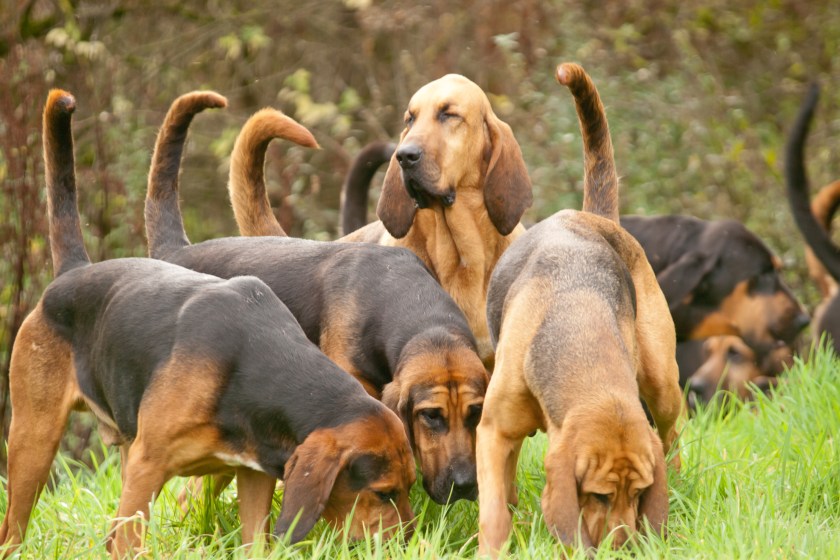
Getty Images, mikedabell
Breed Characteristics: Large size, keen sense of smell, great demeanor, very trainable
The bloodhound is the largest of the scent-tracking dogs on this list and also boasts one of the most impressive résumés: It's been trained to track deer, wild boar, escaped prisoners, and missing people since the 14th century.
With a drive as strong as any gun dog out there, the bloodhound will stop at nothing to find the end of a scent trail, which can be as much of a resource as it can be a liability, making consistent training essential.
Generally weighing between 85 and 120 pounds, these dogs are huge—as is the amount of drool they produce.
18. Coonhound
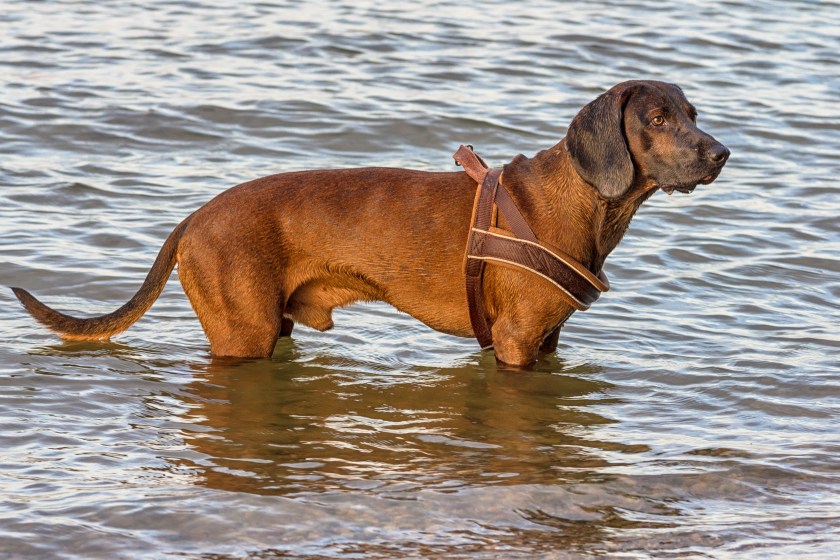
Getty Images, devnenski
Breed Characteristics: Excellent tracking skills, great in packs, low maintenance
All told, there are six coonhound breeds, each descending from various lines of foxhounds and bloodhounds. Each has made a name for itself in the field, specializing in the ability to tree an animal and still hold a scent.
Black and Tan Coonhound: Weighing 40 to 77 pounds, this breed has markings that resemble those of a Doberman and a Rottweiler and descends from the bloodhound and the black and tan Virginia foxhound. While its bread and butter is chasing raccoons, the black and tan coonhound is more than capable at hunting deer, bears, and other predators.
Redbone Coonhound: Commonly recognized from the novel Where the Red Fern Grows, the redbone coonhound descends from the English foxhound, the Welsh hound, the harrier, the beagle, the Grand Bleu de Gascogne and the bloodhound. Known for its stamina, the redbone will run as hard and bark as loud as any hound out there and excels when working within a pack.
Treeing Walker Coonhound: Possibly the most docile of the six, the treeing walker radiates a mellow attitude that also makes it a wonderful house pet. It can tree any animal, but it's gradually become a favorite of deer hunters who can legally hunt with dogs. The treeing walker's speed is tough to match, and hunters have taken notice.
Bluetick Coonhound: Blueticks tend to offer a more gentle, trainable temperament than other coonhounds, yet holds its own in the tracking department. The bluetick doesn't reserve its excellent nose for one prey animal, either. It'll chase any scent it comes across and will tree or corner just about any animal. For that reason, it's probably best to avoid interactions with cats.
American English Coonhound: Also known as the redtick coonhound or simply the English coonhound, this sub-breed can tree larger prey such as a bear or a cougar, but it's become one of the most popular for hunting raccoons.
Plott Hound: Defined by its grittiness and determination to finish any job, the Plott is likely the most underrated gun dog on this entire list. The North Carolina state dog has proven itself as the ultimate bear-hunting dog with its ability to tree a bear and fearlessly hold its ground.
19. Beagle
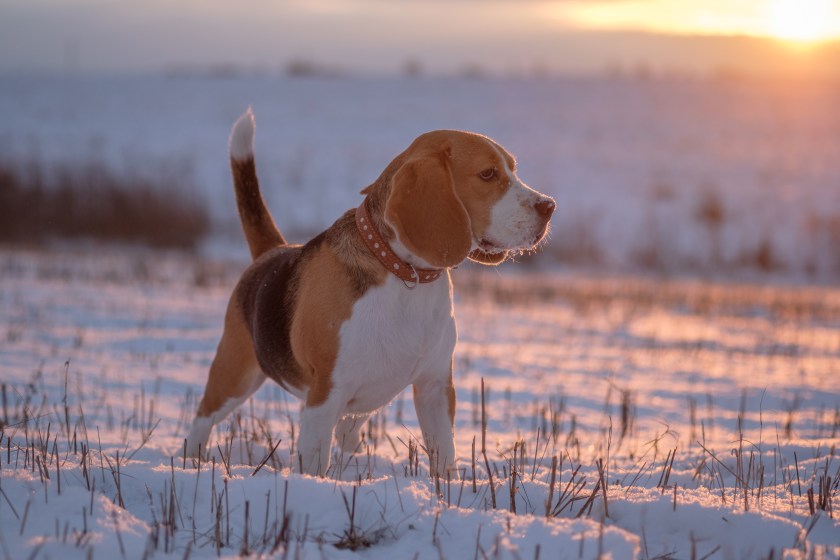
Getty Images, androsov58
Breed Characteristics: Excellent at rabbit hunting, small size, friendly
Not only is the beagle an American classic, it's the undisputed king of rabbit hunting. No other dog can stay in hot pursuit of a bolting rabbit and strategically drive it all the way back to you. The beagle works exceptionally well with reinforcements, so a pack will hold much tighter to a trail than one running solo.
The beagle's nose is up there with the bloodhound's, too. In the 1950s, a study tested different dogs' scenting abilities by randomly placing a mouse in a one-acre field and letting the dogs loose. Fox terriers took over 15 minutes to locate the mouse, and many other breeds didn't find it at all. The beagles in the study found it in less than a minute.
Like most hounds, beagles are barkers, which can be managed by the right owner but can also be problematic at home. Their small size (typically no more than 25 pounds) and drive to please their owners have made them one of the most popular house pets in terms of hunting breeds, as long as they're well-exercised.
20. American Foxhound
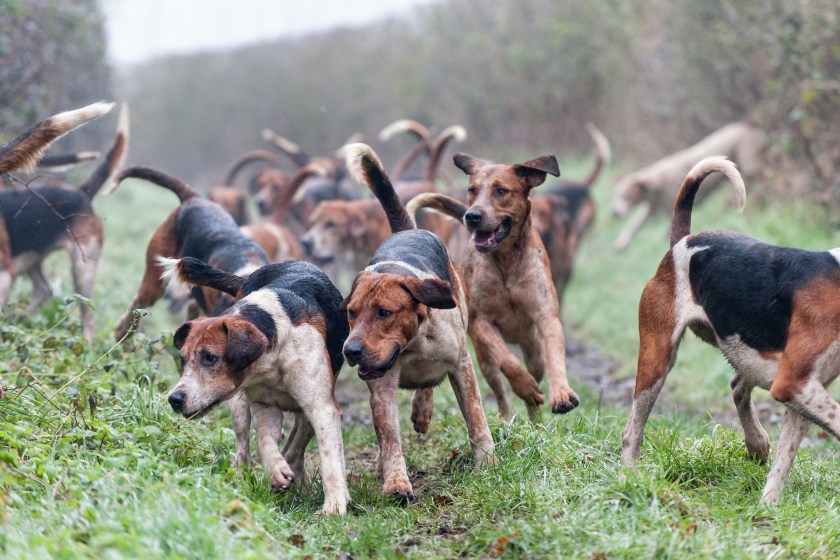
Getty Images, dageldog
Breed Characteristics: Driven, high-energy, great in packs
Along with its close relative the English foxhound, the American foxhound carries a story of sophistication—something rarely attached to hounds. As you might've guessed, these breeds specialize in fox hunting, but they hunt with a much different style than other hounds, in that they're nonreactive to horses. Fox hunting on horseback dates back to 1534, and the tradition has lived on in a number of countries, including the United States. No other gun dog has a working relationship with a second animal, and the nearly 500-year-old chemistry between foxhounds and horses is undeniable.
Foxhounds have as strong of a drive as any other hound, powered by its often-excessive level of energy. Foxhounds can make great pets given the right attention.
